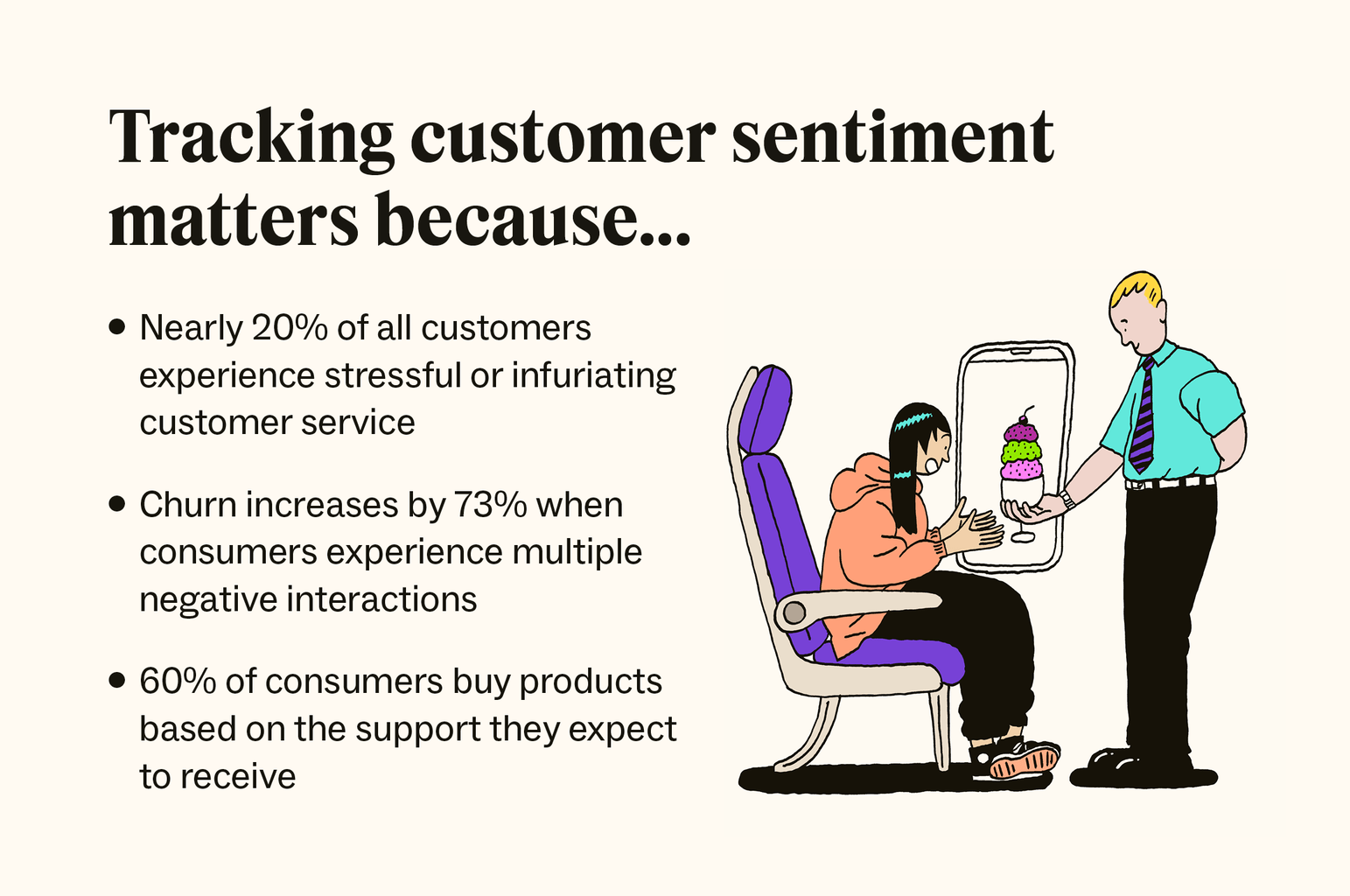Article • 1 min read
Customer sentiment: What it is and why you need to measure it
Customer sentiment is a metric that businesses use to measure how their customers think and feel about their brand. Learn how to measure it in this guide.
출처 Mark Smith, Staff Writer
최종 업데이트: January 16, 2025
Imagine walking into your favorite coffee shop and being greeted with a smile as your go-to drink is handed to you before you even have to order. That kind of positive customer experience (CX) leaves a lasting impression. Now, picture the opposite: a long wait, grumpy staff, and the wrong coffee order. These experiences don’t just fade away—they create lasting feelings, for better or worse. And for businesses, understanding those feelings isn’t just nice; it’s essential.
The metric that measures these feelings is customer sentiment, which helps companies tap into the emotions behind every interaction, from cheers to complaints. Whether through classic tools like Net Promoter Scores (NPSs) or high-tech AI that decodes tone and intent, capturing customer sentiment helps brands read between the lines.
In this guide, we dive into what customer sentiment is, how it’s analyzed, and why it matters for business success.
More in this guide:
What is customer sentiment?

Customer sentiment is a metric that businesses use to measure how their customers think and feel about their brand. Despite its simplicity—it tracks whether users have positive, negative, or neutral views of the company—customer sentiment plays a critical role in how well a company retains customers and its ability to grow revenue.
Also known as user sentiment, companies must pay attention to customer sentiment metrics to not only support their bottom line but also protect customers from real emotional damage. According to Zendesk benchmark data, 66 percent of consumers say that a bad experience can ruin their day, meaning poor customer service and experiences can affect more than business outcomes.
What is customer sentiment analysis?
Customer sentiment analysis is when a company uses automation to examine the feedback customers leave in surveys, social media posts, and more. The process uses machine learning and deep learning to analyze huge amounts of customer data, scanning interactions to identify negative, positive, and neutral language to gauge how consumers view businesses.
In AI-powered ticketing automation, sentiment analysis ensures support requests go to the right agents. This analysis can also provide an overview of the types of tickets being submitted, which helps support teams identify common issues.
What is a customer sentiment score?
A customer sentiment score is a metric that analyzes the phrases and words customers use to measure their sentiment. These scores provide context to customer feelings by assigning values to specific events. These measurements can then be added together, leading to an overall score that can be expressed on a range of one to 100 (with one being very positive and 100 hopping mad).
These customer sentiment scores can play a crucial role in ticket routing. For example, they can identify tickets requiring higher empathy and should be sent to more experienced agents. Plus, these scores can also serve as a warning—if you’re seeing a large number of negative customer sentiment scores, it could point to a recurring problem with your products or services.
Use cases of customer sentiment analysis
According to customer service statistics from Zendesk benchmark data, two-thirds of consumers who believe a business cares about their emotional state will become repeat customers. However, beyond creating return customers, here are some of the many use cases for customer sentiment analysis:
Measuring the efficacy of recent marketing efforts
Gaining a deeper understanding of customer demographics
- Identifying and targeting the root causes of a decrease in customer satisfaction (CSAT)
Tracking down customers who harbor very negative views of your business for remediation
This is not an exhaustive list of use cases, and customer sentiment analysis can improve CX when it is uniquely adapted to support individual businesses.
Benefits of customer sentiment analysis
There are significant benefits to customer sentiment analysis, including reduced customer churn, cross-selling and up-selling opportunities, employee training, and enhanced AI performance.
Below, we’ve included the top benefits of customer sentiment analysis.
Simplifies customer needs and expectations
Understanding what customers truly want can feel like solving a complex puzzle, but customer sentiment analysis simplifies this process by decoding the emotions behind their interactions. Sentiment tools identify patterns that reveal core needs and expectations by analyzing feedback, reviews, and support conversations.
These insights cut through the noise, providing a clear roadmap for improvements. Instead of guessing about customer expectations, businesses gain a direct line to their priorities, helping them align services and products to meet—and even exceed—those needs.
Helps support teams perform better
With advanced insight into customer pain points and preferences, customer sentiment analysis helps teams understand the context behind each interaction—whether it’s frustration, satisfaction, or indifference. Agents can tailor their responses more effectively, showing empathy or reinforcing positive experiences.
Real-time sentiment data also helps managers identify trends, such as recurring issues or training gaps, enabling proactive improvements. Ultimately, this leads to more personalized, impactful support, turning routine interactions into opportunities to delight consumers and build lasting customer relations.
Guides improvements for products and services
Customer sentiment touches every aspect of your business, from how your product works to the overall view of your brand, and it will show you ways to improve your products and services. If you listen closely, customers will tell you—implicitly or simply via their anger—what’s working and what’s not meeting their expectations.
For example, if your analysis points toward consumer frustration with your e-commerce site’s shopping cart, you can share that data with your product team to prioritize bug fixes and user enhancements.
How to measure customer sentiment
There are a host of ways businesses can track and analyze customer sentiment, and there is no one-size-fits-all approach to measuring user sentiment.
AI-powered tools
AI-powered tools analyze vast amounts of customer data using natural language processing (NLP) and machine learning algorithms. These tools scan customer interactions—like chat conversations, emails, reviews, and social media posts—to detect emotional tones and context. This real-time analysis helps businesses quickly spot emerging issues or trends, ensuring they stay in tune with their customers’ evolving needs and emotions.
By identifying patterns in language, AI tools like AI copilot can classify sentiment as positive, negative, or neutral and even gauge the intensity of emotions. Advanced tools—like AI agents—can also provide more accurate and detailed views of customer feelings.
Customer service software
Customer service software collects feedback from various touchpoints—like support tickets, live chats, and emails—and uses built-in sentiment analysis features to interpret the tone and context of customer communications. Some advanced systems even create advanced feedback loops by highlighting key phrases and trends, helping teams identify common pain points or opportunities for improvement.
For example, Zendesk is an AI-powered customer service solution that uses sentiment analysis features to help agents provide personalized customer support to all consumers.
Social media monitoring
Social media monitoring allows businesses to analyze what customers say and how they feel in real time. Businesses can gauge public opinion and detect emotional trends by tracking mentions, comments, and reviews across social media platforms.
While you can do this manually, teams can use AI-powered tools to scan posts and identify positive, neutral, and negative sentiments. These tools can also recognize key themes, hashtags, and even subtle tones of sarcasm or frustration. This analysis provides a clearer picture of brand perception and helps companies respond quickly to emerging issues or capitalize on positive buzz. Monitoring social sentiment also ensures you’re listening and truly understanding your customers in their own digital spaces.
Direct feedback
Direct feedback remains one of the most valuable sources for measuring customer sentiment, offering insights straight from the source. Customer satisfaction surveys, follow-up emails, and forms for customer feedback provide structured spaces for audiences to willingly share their experiences.
AI-powered tools enhance this process by analyzing responses for sentiment and tone, identifying underlying emotions beyond simple ratings. For example, a buyer rating customer service as “good” might express frustration in their comments, where AI can detect and identify nuances that traditional analysis might miss.
Net Promoter Scores
NPS provides a clear, numerical gauge of customer sentiment by asking a simple yet powerful question: “On a scale from 0 to 10, how likely are you to recommend our service?” While the initial findings from this question are powerful, AI tools can take NPS analysis further by diving into the open-ended follow-up responses often included in these surveys.
By applying NLP to these comments, AI can extract deeper emotional insights, identifying whether promoters (9-10) express genuine enthusiasm or if detractors (0-6) reveal specific pain points. This combination of quantitative scoring and qualitative sentiment analysis gives a holistic view of customer loyalty and emotional engagement, helping businesses pinpoint what drives satisfaction—or frustration—to enhance their customer experience strategy.
Tips on creating actionable insights with your customer sentiment data
Tracking and analyzing customer sentiment is all well and good, but all that data also needs to be put to use. While not all customer sentiment data will point toward problems, you still need actionable insights that will provide a clear roadmap of how to address certain feelings and trends.
Here are some tips for creating actionable insights with customer sentiment data:
- As you analyze customer sentiment data, map the issues revealed by the data. This ensures you identify every type of customer issue and prioritize the categories that need immediate attention.
- Sort the data by customer type, using demographics or business-specific customer service metrics like CSAT and length of customer loyalty. This can help you target what’s working and what’s not meeting customer expectations.
- Compile customer sentiment and examine data over time to plot where spikes in negative (or positive) sentiment occur.
Depending on your goals and business needs, you can use each method above to collect unique, actionable insights and compare different data markers.
Frequently asked questions


Motel Rocks
Motel sees self-service climb by 3X and faster ticket handling with Zendesk AI
“We implemented Zendesk AI earlier this year, it’s ready straight out of the box, and everyone knew what they were doing. It’s really intuitive, we didn’t have to change any core processes, it is just another button that will help you and show you the information.”
Lucy Hussey
Customer Service Manager
Customer sentiment and the move toward immersive CX
According to the Zendesk Customer Experience Trends Report 2025, 61 percent of customers expect more personalized service with AI. With customer sentiment technology and customer data available at your fingertips, customers expect product and service improvements based on their feelings about the companies they patronize.
To stay ahead of the competition—and meet customer needs and expectations—companies must make customer sentiment analysis a key component of their business strategy. With Zendesk AI, you can do just that. Our AI-powered solution is built on billions of real customer service interactions, allowing you to automatically analyze customer sentiment and provide personalized service without incurring additional costs or stretching your resources.
Discover the power of personalized support by learning more about Zendesk AI today.
Net Promoter and NPS are registered U.S. trademarks, and Net Promoter Score and Net Promoter System are service marks of Bain & Company, Inc., Satmetrix Systems, Inc., and Fred Reichheld.
